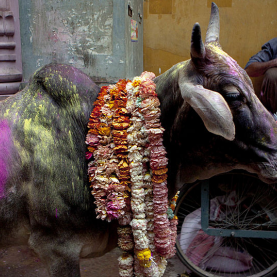Ghee
Dairy products hold a special place in Hinduism, both as a ritual offering and as part of the daily diet. Ghee in particular, prepared with churned yoghurt, is held in high regard, both for its taste and for its nourishing properties.
A long tradition of ‘pure’ food
Dairy products are granted special status in Hinduism. According to Hindu mythology, the universe and the earth were created from the churning of an ocean of milk. The anthropologist Marie-Claude Mahias believes that the mention of transforming milk into butter in the Hindu creation myth illustrates a process of ‘setting the world in order out of the original chaos’. Milk, yoghurt and ghee (from the Sanskrit ghṛtá meaning ‘clarified butter’) have long since been used as an offering on altars and likened to the food of the gods. The consumption of milk, yoghurt and ghee has been part of the daily Indian diet since the first millennium BCE.
Food fried in ghee (butter which has been boiled to remove its impurities) was particularly valued. It was classed as ‘pakka’, meaning it is cooked, stable and pure. Conversely, ‘kacha’ food is vulnerable and subject to impurities. Today too, ‘pakka’ food prepared with ghee is seen as festive and delicious, served as a sign of hospitality or given as a gift. Ghee is also recommended in traditional Ayurvedic medicine to facilitate digestion and, when applied to the skin, to treat burns.
Preparation and use of ghee in India
In India, ghee is made with yoghurt. Churning traditionally occurs in a terracotta dish. The yoghurt is stirred until pieces of butter form. This butter is then brought to the boil and, as the water evaporates, particles of casein (milk proteins) form on the bottom and the whole mixture is filtered. Ghee is not only appreciated for its taste, but also has the advantage of keeping for weeks.
Since ghee is expensive, whether it is used abundantly or sparingly can be an indicator of a family’s status. Ghee is used in confectionery and is also poured over cooked dishes such as poppadoms, curries or porridge. Hydrogenated vegetable oils often replace the use of ghee as a cooking or frying fat, as they are cheaper, but similar in appearance.
Emergence of a new dietary practice
As the popularity of ghee and sweet products demonstrates, high calorie food is sought after in India, because it is seen as a sign of prosperity. However, over the last fifteen years, the medical profession has become concerned about the health effects of traditional cooking, deemed to be too rich and too greasy. Among the wealthy social classes, the trend is for lower fat cuisine, both for health reasons and because being slim has become a new aesthetic ideal. Proof of this can be seen in today’s ever slimmer Bollywood actresses.
Cousin Françoise, 1999. Des aliments fermentés au Rajasthan (Inde). Ferments en folie. Vevey : Fondation Alimentarium.
Assouly, Olivier, 2002. Les nourritures terrestres. Paris : Actes Sud.
Quien, Aleandra, 2007. Dans les cuisines de Bombay. Paris : Éditions Karthala.
Mahias, Marie-Claude, 2002. Le barattage du monde. Partis : Éditions de la Maison des sciences de l’homme.







